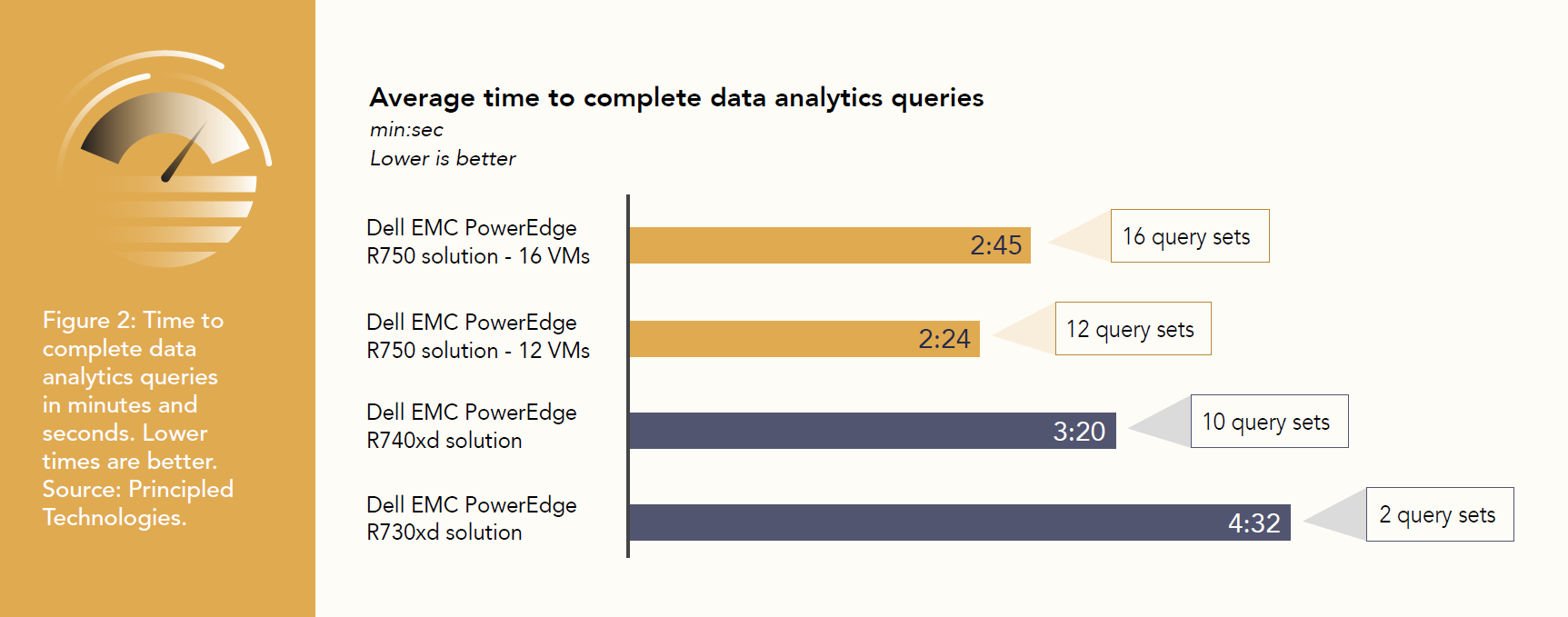Home > Servers > Rack and Tower Servers > Intel > White Papers > Analyze more data, faster, by upgrading to latest-generation Dell EMC PowerEdge R750 servers > Our results
Our results
-
The previous study, available at http://facts.pt/6yh586b, aimed to show how a company’s analytics work could benefit by upgrading from older servers to a Dell EMC PowerEdge R740xd server with newer components.
We’ve continued that work in this study with the latest-generation Dell EMC PowerEdge R750 server, comparing its analytics performance results to those we found in the previous study. Thanks in part to its 3rd Generation Intel Xeon Scalable Gold processors and a RAID controller that supports hardware RAID configurations of PCIe Gen4 NVMe 4.0 drives, the latest-generation PowerEdge R750 servers show strong performance improvements compared to PowerEdge R740xd and R730xd models. Note: We did not include the PowerEdge R720 results from the previous study in this report because we assume those servers play a diminished role in today’s data centers.
Run more data warehouse workloads
We ran the workload on as many VMs as each server could handle. Thus, the servers that supported more VMs also could handle more workloads.
In our previous study, a PowerEdge R730xd server supported just 2 VMs before its performance decreased dramatically. Compared to the seven-year-old PowerEdge R730xd, the PowerEdge R750 running 16 VMs completed eight times the work and running 12 VMs completed six times the work.
The previous-generation PowerEdge R740xd server from our previous study, which had NVMe SSDs in a Microsoft Storage Spaces configuration, was more capable than the PowerEdge R730xd, supporting 10 VMs before it showed signs of saturation. Compared to the PowerEdge R740xd, the latest-generation PowerEdge R750 ran 60 percent more work when handling 16 VMs. Supporting 12 VMs, the latest-generation server did 20 percent more work than the PowerEdge R740xd server. Figure 1 shows the VM quantity each solution supported while running our query workload.
We’ve continued that work in this study with the latest-generation Dell EMC PowerEdge R750 server, comparing its analytics performance results to those we found in the previous study. Thanks in part to its 3rd Generation Intel Xeon Scalable Gold processors and a RAID controller that supports hardware RAID configurations of PCIe Gen4 NVMe 4.0 drives, the latest-generation PowerEdge R750 servers show strong performance improvements compared to PowerEdge R740xd and R730xd models. Note: We did not include the PowerEdge R720 results from the previous study in this report because we assume those servers play a diminished role in today’s data centers.
Run more data warehouse workloads
We ran the workload on as many VMs as each server could handle. Thus, the servers that supported more VMs also could handle more workloads.
In our previous study, a PowerEdge R730xd server supported just 2 VMs before its performance decreased dramatically. Compared to the seven-year-old PowerEdge R730xd, the PowerEdge R750 running 16 VMs completed eight times the work and running 12 VMs completed six times the work.
The previous-generation PowerEdge R740xd server from our previous study, which had NVMe SSDs in a Microsoft Storage Spaces configuration, was more capable than the PowerEdge R730xd, supporting 10 VMs before it showed signs of saturation. Compared to the PowerEdge R740xd, the latest-generation PowerEdge R750 ran 60 percent more work when handling 16 VMs. Supporting 12 VMs, the latest-generation server did 20 percent more work than the PowerEdge R740xd server. Figure 1 shows the VM quantity each solution supported while running our query workload.

See results from data analytics workloads soonerHaving data center resources that allow users to do more work is great—it allows IT decision makers to consider consolidating workloads onto fewer servers or increasing a data center’s virtual density without increasing its physical footprint. Speed, however, plays a crucial role in seeing insight sooner. The two VMs on the PowerEdge R730xd took an average of 4 minutes and 53 seconds to complete the workload. While the previous-generation PowerEdge R740xd was faster (completing its 10 sets of 22 queries in 3 minutes and 20 seconds on average), both configurations of the latest-generation PowerEdge R750 managed to complete more workloads in even less time than either of the two older servers.
The latest-generation server completed 16 sets of queries at an average pace of 2 minutes and 45 seconds per workload, 39 percent less time than the PowerEdge R730xd and 17 percent less time than the PowerEdge R740xd. With 12 sets of queries, the latest-generation server completed the workload at an average pace of 2 minutes and 24 seconds per workload, 47 percent less time than the PowerEdge R730xd and 28 percent less time than the PowerEdge R740xd. Figure 2 illustrates our findings for this study and compares them to select findings from the previous study.

